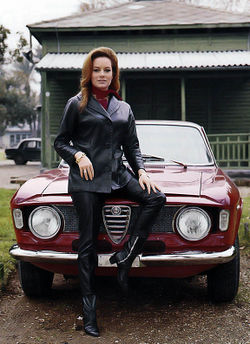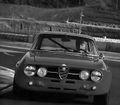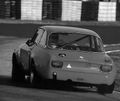Difference between revisions of "Alfa Romeo GTA"
m |
m |
||
| (53 intermediate revisions by the same user not shown) | |||
| Line 1: | Line 1: | ||
| − | + | {{X}} | |
| − | {| border=1 | + | {| border=1 cellspacing=3 cellpadding=4 style="float:right; margin:0 0 .5em 1em; width:250px; background:#505050; border-collapse:collapse; border:1px solid #999; font-size:83%; line-height:1.5; " summary="Infobox Automobile" |
| − | |- | + | |- style="text-align:center; background:#505050;" |
| − | |colspan=2|[[Image:Alfa GTA. | + | | colspan=2 style="padding:0; background:#333333; color:#fff; border-bottom:1px solid #999;" |[[Image:Alfa Romeo Giulia Sprint GTA.jpg|280px|Alfa Romeo GTA]] |
| − | |- | + | |- style="color:#fff; background:darkred; font-size:larger;" |
| − | + | ! colspan=2 |'''Alfa Romeo GTA''' | |
|- | |- | ||
|Manufacturer:||[[Alfa Romeo]] | |Manufacturer:||[[Alfa Romeo]] | ||
| Line 20: | Line 20: | ||
|Engines:||1570 cc | |Engines:||1570 cc | ||
|- | |- | ||
| + | | colspan=2 style="padding:0; background:#333333; color:#fff; border-bottom:1px solid #999;" |<videoflash>kTiJjnPkEO8|280|200</videoflash> | ||
|} | |} | ||
| + | |||
The '''Alfa Romeo GTA''' was a [[coupé]] [[automobile]] manufactured by the [[Italy|Italian]] manufacturer [[Alfa Romeo]] from 1962 to 1971. | The '''Alfa Romeo GTA''' was a [[coupé]] [[automobile]] manufactured by the [[Italy|Italian]] manufacturer [[Alfa Romeo]] from 1962 to 1971. | ||
| Line 26: | Line 28: | ||
In 1962, the successor for the very popular Giulietta Coupé, internally called the "Series 105", was introduced. It used the shortened floorpan from the Giulia Berlina car and was designed by [[Bertone]]. The name of the car evolved from Giulia Sprint GT to Giulia Sprint and to GTJ ([[GT 1300 Junior|Junior]]) and GTV ([[Alfa Romeo Sprint GT (Veloce)|Veloce]]) in the late 1960s. | In 1962, the successor for the very popular Giulietta Coupé, internally called the "Series 105", was introduced. It used the shortened floorpan from the Giulia Berlina car and was designed by [[Bertone]]. The name of the car evolved from Giulia Sprint GT to Giulia Sprint and to GTJ ([[GT 1300 Junior|Junior]]) and GTV ([[Alfa Romeo Sprint GT (Veloce)|Veloce]]) in the late 1960s. | ||
| − | At the time, Alfa was very active in [[motorsport]]. Autodelta, the racing division of Alfa, developed a car for competition close to the | + | At the time, Alfa was very active in [[motorsport]]. Autodelta, the racing division of Alfa, developed a car for competition close to the road going model. These cars were named GTA instead of GT, the 'A' standing for "Allegerita", Italian for lightweight. |
| − | Using lots of [[ | + | Using lots of [[aluminum]] panels and by fitting a new 8-spark plug (twin spark, twin plug) cylinder head, this car boasted 170[[bhp]] in the 1300cc car and up to 240bhp in the 2000cc car - A car usually related to the GTA but unlike the GTA derived from the GTV 1750, the 2000GTAm was created in 1968: There are 2 schools of thought about the "Am", neither one of them ever being confirmed by the factory: one says Allegerita Maggiorata, the other America. Most likely the latter is closest, since the car did not contain any aluminum parts and therefore not "Allegerita", and the base was a GTV 1750 with American injection system for homologation purposes for the American market. Spica was the injection system brand. The 1750 cc was later bored to 1985 cc to meet the 2000 cc limitation of its class to the maximum. Both types the GTA/ GTA 1300 Junior and the GTAm were very successful, these cars were lead to numerous victories. In the opening season at [[Autodromo Nazionale Monza|Monza]], they won the first seven places. [[Andrea de Adamich]] claimed the title in 1966. Later on, the 1750 GTAm and the 2000 GTAm cars were lead to victory by Toine Hezemans, who won the 24 hours of [[Circuit de Spa-Francorchamps|Francorchamps]] with this car. These cars won hundreds of races before competition grew stronger in 1971. But the Giulia sometimes kept up with much bigger engined cars such as the 3 liter [[BMW New Six|CSL BMW's]]. |
| + | |||
| + | [[File:Alfa Romeo Giulia GTA.jpg|thumb|left|250px|'''Alfa Romeo Giulia GTA''']] | ||
| + | {{-}} | ||
== GTA 1300 Junior == | == GTA 1300 Junior == | ||
| − | {| border=1 | + | |
| − | |- | + | {| border=1 cellspacing=3 cellpadding=4 style="float:right; margin:0 0 .5em 1em; width:250px; background:#505050; border-collapse:collapse; border:1px solid #999; font-size:83%; line-height:1.5; " summary="Infobox Automobile" |
| − | |colspan=2|[[Image:Alfa Romeo 1300 Junior GTA.JPG| | + | |- style="text-align:center; background:#505050;" |
| − | |- | + | | colspan=2 style="padding:0; background:#333333; color:#fff; border-bottom:1px solid #999;" |[[Image:Alfa Romeo 1300 Junior GTA.JPG|280px|Alfa Romeo 1300 GTA Junior]] |
| − | + | |- style="color:#fff; background:darkred; font-size:larger;" | |
| + | ! colspan=2 |'''Alfa Romeo GTA Junior''' | ||
|- | |- | ||
|Production || 1968–1972 | |Production || 1968–1972 | ||
| Line 42: | Line 48: | ||
|- | |- | ||
|Engine || 1.3 L [[straight-4]] | |Engine || 1.3 L [[straight-4]] | ||
| + | |- | ||
| + | | colspan=2 style="padding:0; background:#333333; color:#fff; border-bottom:1px solid #999;" |<videoflash>pQhN44CI3QQ|280|200</videoflash> | ||
|} | |} | ||
| − | |||
| + | The '''GTA 1300 Junior''' (1968–1972) had an 1300 cc engine that was based on the 1600 engine but with a short stroke crankshaft. The GTA Junior in 'stradale' form did not have many of the light weight features of the 1600 GTA, such as the plastic windows, magnesium engine components and alloy wheels. At start the engine produced 96PS but was soon raised to 110PS. Autodelta prepared fuel injected racing cars had 165PS. 450 GTA Juniors were produced. | ||
| + | {{-}} | ||
| + | == GTAm == | ||
| − | + | {| border=1 cellspacing=3 cellpadding=4 style="float:right; margin:0 0 .5em 1em; width:250px; background:#505050; border-collapse:collapse; border:1px solid #999; font-size:83%; line-height:1.5; " summary="Infobox Automobile" | |
| − | {| border=1 | + | |- style="text-align:center; background:#505050;" |
| − | |- | + | | colspan=2 style="padding:0; background:#333333; color:#fff; border-bottom:1px solid #999;" |[[Image:GTAm30-340.jpg|280px]] |
| − | |colspan=2|[[Image: | + | |- style="color:#fff; background:darkred; font-size:larger;" |
| − | |- | + | ! colspan=2 |'''Alfa Romeo GTAm''' |
| − | |||
|- | |- | ||
|Production || 1970–1971 | |Production || 1970–1971 | ||
| Line 61: | Line 70: | ||
|- | |- | ||
|Engine || 2.0 L [[straight-4]] | |Engine || 2.0 L [[straight-4]] | ||
| + | |- | ||
| + | | colspan=2 style="padding:0; background:#333333; color:#fff; border-bottom:1px solid #999;" |<videoflash>FjKTZIjkWLc|280|200</videoflash> | ||
|} | |} | ||
| − | The '''GTAm''' (1970–1971) could produce up to 240PS in the 2000 cc car—a car usually related to the GTA, but unlike the GTA derived from the GTV 1750, the 2000GTAm was created in 1968: There are two schools of thought about the "Am", neither one of them ever being confirmed by the factory: one says Alleggerita Maggiorata (" | + | The '''GTAm''' (1970–1971) could produce up to 240PS in the 2000 cc car—a car usually related to the GTA, but unlike the GTA derived from the GTV 1750, the 2000GTAm was created in 1968: There are two schools of thought about the "Am", neither one of them ever being confirmed by the factory: one says Alleggerita Maggiorata ("lightened enlarged", in Italian), the other America Maggiorata. Most likely the latter is closest, since the car body did not contain any aluminum part and therefore was not "Allegerita", and the base was a GTV 1750 with American injection system for homologation purposes for the American market. [[SPICA]] was the injection system brand. The 1750 (actually 1779 cc) was bored to 1985 cc to meet the 2000 cc limitation of its class to the maximum, so explaining what "maggiorata" stands for. |
| + | <gallery> | ||
| + | File:Alfa Romeo 1750 GTAm Autodelta (1970_1).jpg|'''1970 Alfa Romeo 1750 GTAm [[Autodelta]]''' | ||
| + | File:Alfa Romeo 1750 GTAm Autodelta (1970_2).jpg | ||
| + | File:Alfa Romeo 1750 GTAm Autodelta (interno).jpg|'''Alfa Romeo 1750 GTAm Autodelta interior''' | ||
| + | </gallery> | ||
| + | {{-}} | ||
== GTA-SA == | == GTA-SA == | ||
| − | {| border=1 | + | |
| − | |- | + | {| border=1 cellspacing=3 cellpadding=4 style="float:right; margin:0 0 .5em 1em; width:250px; background:#505050; border-collapse:collapse; border:1px solid #999; font-size:83%; line-height:1.5; " summary="Infobox Automobile" |
| − | |colspan=2|[[ | + | |- style="text-align:center; background:#505050;" |
| − | |- | + | | colspan=2 style="padding:0; background:#333333; color:#fff; border-bottom:1px solid #999;" |[[File:GTA SA engine_edited-1.jpg.jpg|250px]] |
| − | + | |- style="color:#fff; background:darkred; font-size:larger;" | |
| + | ! colspan=2 |'''Alfa Romeo GTA-SA''' | ||
|- | |- | ||
|Production || 1967–1968 | |Production || 1967–1968 | ||
|- | |- | ||
| − | | | + | |Body style || 2-door [[coupe]] |
|- | |- | ||
|Engine || 1.6 L [[straight-4]] supercharged | |Engine || 1.6 L [[straight-4]] supercharged | ||
|} | |} | ||
| − | |||
| + | The Giulia 1600 '''GTA-SA''' (sovralimentato or [[supercharged]]) (1967–1968) was very rare racing car, of which only 10 copies were built. The car featured a 1570 cc twinspark engine with two oil driven superchargers and could produce up to 250 PS at 7500 rpm. The GTA-SA was built for FlA Group 5 racing in Europe and it won first place overall in the Hockenheim 100 mile endurance race in 1967 in the hands of the German driver Siegfried Dau. | ||
| + | {{-}} | ||
== Racing success == | == Racing success == | ||
| − | |||
| − | ==Modern Alfa | + | Both types the GTA/ GTA 1300 Junior and the GTAm were very successful, these cars were led to numerous victories. In the opening season at [[Autodromo Nazionale Monza|Monza]], they won the first seven places. [[Andrea de Adamich]] claimed the title in 1966. Later on, the 1750 GTAm and the 2000 GTAm cars were led to victory by Toine Hezemans, who won the 24 hours of [[Circuit de Spa-Francorchamps|Francorchamps]] with this car. These cars won hundreds of races before competition grew stronger in 1971. But the Giulia sometimes kept up with much bigger engined cars such as the 3 liter [[BMW E9|BMW CSL]]. |
| + | |||
| + | |||
| + | == Technical data == | ||
| + | |||
| + | {| border=1 cellspacing=3 cellpadding=4 style="float:center; margin:0 0 .5em 1em; width:800px; background:#505050; border-collapse:collapse; border:1px solid #999; font-size:83%; line-height:1.5; " summary="Infobox Automobile" | ||
| + | |- style="text-align:center; background:#505050;" | ||
| + | |- tr BGCOLOR=darkred | ||
| + | ! width="12%"|GTA: | ||
| + | ! width="14%"|Giulia Sprint GTA | ||
| + | ! width="14%"|Giulia Sprint GTA (racing version) | ||
| + | ! width="14%"|Giulia GTA 1300 Junior | ||
| + | ! width="14%"|Giulia GTA 1300 Junior (racing version) | ||
| + | ! width="14%"|GTA SA | ||
| + | ! width="14%"|GTAm | ||
| + | |----- bgcolor="#505050" | ||
| + | |Engine: || colspan="6" align="center" |straight-4 | ||
| + | |----- bgcolor="#505050" | ||
| + | |Displacement: || align="center" | 1570 cc || align="center" | 1570 cc || align="center" | 1290 cc ||align="center" | 1290 cc || align="center" | 1570 cc || align="center" | 1985 cc | ||
| + | |----- bgcolor="#505050" | ||
| + | |Bore x stroke: || align="center" | 78 mm x 82 mm ||align="center" | 78 mm x 82 mm || align="center" | 78 mm x 67.5 mm || align="center" | 78 mm x67.5 mm || align="center" | 78 mm x 82 mm || align="center" | 845 mm x 88.5 mm | ||
| + | |----- bgcolor="#505050" | ||
| + | |Power: || align="center" | 115 PS ||align="center" | 164 PS || align="center" | 96 PS ||align="center" | 180 PS || align="center" | 220 PS || align="center" | 240 PS | ||
| + | |----- bgcolor="#505050" | ||
| + | |at rpm: || align="center" |6000 || align="center" |7800 || align="center" |6000 ||align="center" |9300 || align="center" | 7800|| align="center" |7500 | ||
| + | |----- bgcolor="#505050" | ||
| + | |Compression: || align="center" |9,7 : 1 || align="center" |10,5 : 1 || align="center" |9,7 : 1 || align="center" |11,0 : 1 || align="center" |10,5 : 1 || align="center" | 11,0 : 1 | ||
| + | |----- bgcolor="#505050" | ||
| + | |Valves per cylinder: || align="center" | 2 || align="center" | 2 || align="center" | 2 || align="center" | 4 || align="center" | 2 || align="center" | 2 | ||
| + | |----- bgcolor="#505050" | ||
| + | |Valve control: || colspan="6" align="center" |Double overhead camshaft | ||
| + | |----- bgcolor="#505050" | ||
| + | |Transmission: || colspan="6" align="center" |5-speed gearbox | ||
| + | |----- bgcolor="#505050" | ||
| + | |Brakes: || colspan="6" align="center" |Disc brakes all around | ||
| + | |----- bgcolor="#505050" | ||
| + | |Suspension front: || colspan="6" align="center" |Independent suspension, wishbones , coil springs, anti-roll bar | ||
| + | |----- bgcolor="#505050" | ||
| + | |Suspension rear: || colspan="6" align="center" |Live Axle , trailing arms, coil springs, telescopic dampers | ||
| + | |----- bgcolor="#505050" | ||
| + | |Body: || colspan="5" align="center" |two-door, aluminum panels over steel monocoque|| colspan="1" align="center" |two-door from steel | ||
| + | |----- bgcolor="#505050" | ||
| + | |Weight: || align="center" | 820 kg || align="center" | 760 kg || align="center" | 920 kg || align="center" | 760 kg || align="center" | || align="center" | 920 kg | ||
| + | |----- bgcolor="#505050" | ||
| + | |Top speed: || align="center" | 185 km/h || align="center" | 220 km/h || align="center" | 175 km/h || align="center" | 210 km/h || align="center" | 240 km/h || align="center" | 230 km/h | ||
| + | |----- bgcolor="#505050" | ||
| + | |Construction: || align="center" |1965 - 1969|| align="center" |1965 - 1969|| align="center" |1968 - 1975|| align="center" |1968 - 1975|| align="center" |1967 - 1968|| align="center" |1970 - 1971 | ||
| + | |----- bgcolor="#505050" | ||
| + | |Quantity: ||colspan="2" align="center" |500|| align="center" |193|| align="center" |300|| align="center" |10|| align="center" |40 | ||
| + | |} | ||
| + | |||
| + | |||
| + | == Modern GTAs == | ||
| + | |||
| + | The designation GTA is now used on the highest performance versions of Alfa Romeo road cars, such as the 147 and now discontinued 156. These cars are powered by V6 engines giving them the most power of the cars in the model range, however despite the GTA name, they are generally the heaviest cars in the range, due to having large engines and little if any weight saving employed in their construction. For example, the 147 GTA weighs 1360 kg. | ||
| + | |||
| + | ===147=== | ||
| + | The [[Alfa Romeo 147#High-performance versions|147 GTA]] was introduced in 2002 as the top-end hatchback model for Alfa Romeo. It is powered by a 3.2 litre V6, derived from the 164 from the early 90s. It is a two-door hatchback that seats five, and is characterized by its wider wheel arches, teledial 17 inch wheels, and more aggressive grille design. | ||
| + | |||
| + | ===156=== | ||
| + | The [[Alfa Romeo 156#GTA version|156 GTA]] was Alfa Romeo's sportiest version of the 156, and used the same 3.2 liter V6 as the 147 GTA, producing 250 PS and 300 Nm lb·ft of torque. This four-door saloon was available in sedan or wagon versions. | ||
| + | |||
| + | ===Mito=== | ||
| + | The [[Alfa Romeo MiTo#MiTo GTA concept|Mito GTA]] is a 1.75 liter, turbocharged [[straight-4]], producing 240 PS. | ||
| + | |||
| − | + | == See also == | |
| + | *[[Alfa Romeo in motorsport]] | ||
| + | *[[Alfa Romeo in Formula One]] | ||
| + | *[[Alfa Corse]] | ||
==External links== | ==External links== | ||
*[http://www.alfa-romeo-uk.com/alfa/ The Alfa Romeo car company] | *[http://www.alfa-romeo-uk.com/alfa/ The Alfa Romeo car company] | ||
| + | * [http://www.touringcarracing.net/ History of the European Touring Car racing championship - Cars and Results] | ||
| + | * [http://www.alfaromeogtam.blogspot.com/ A link to an Alfa Romeo GTAm restoration web site - pictures and history of the restoration of this classic racer] | ||
== References == | == References == | ||
| Line 102: | Line 189: | ||
| − | [[Image:DSC05733.jpg|thumb| | + | [[Image:DSC05733.jpg|thumb|300px]] |
| − | [[Image:alfa-romeo-g-150.jpg|thumb| | + | [[Image:alfa-romeo-g-150.jpg|thumb|300px]] |
| − | [[image:alfa147gta02.jpg|thumb| | + | [[image:alfa147gta02.jpg|thumb|300px]] |
Latest revision as of 21:22, 2 July 2012
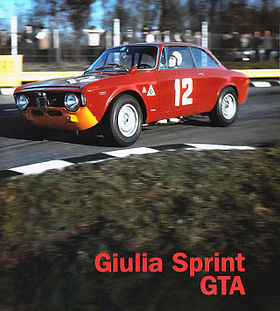
| |
| Alfa Romeo GTA | |
|---|---|
| Manufacturer: | Alfa Romeo |
| Class: | front-engined coupe |
| Production: | 1962- 1971 |
| Predecessor: | Giulietta Coupé |
| Successor: | |
| Body styles: | coupé |
| Engines: | 1570 cc |
The Alfa Romeo GTA was a coupé automobile manufactured by the Italian manufacturer Alfa Romeo from 1962 to 1971.
In 1962, the successor for the very popular Giulietta Coupé, internally called the "Series 105", was introduced. It used the shortened floorpan from the Giulia Berlina car and was designed by Bertone. The name of the car evolved from Giulia Sprint GT to Giulia Sprint and to GTJ (Junior) and GTV (Veloce) in the late 1960s.
At the time, Alfa was very active in motorsport. Autodelta, the racing division of Alfa, developed a car for competition close to the road going model. These cars were named GTA instead of GT, the 'A' standing for "Allegerita", Italian for lightweight.
Using lots of aluminum panels and by fitting a new 8-spark plug (twin spark, twin plug) cylinder head, this car boasted 170bhp in the 1300cc car and up to 240bhp in the 2000cc car - A car usually related to the GTA but unlike the GTA derived from the GTV 1750, the 2000GTAm was created in 1968: There are 2 schools of thought about the "Am", neither one of them ever being confirmed by the factory: one says Allegerita Maggiorata, the other America. Most likely the latter is closest, since the car did not contain any aluminum parts and therefore not "Allegerita", and the base was a GTV 1750 with American injection system for homologation purposes for the American market. Spica was the injection system brand. The 1750 cc was later bored to 1985 cc to meet the 2000 cc limitation of its class to the maximum. Both types the GTA/ GTA 1300 Junior and the GTAm were very successful, these cars were lead to numerous victories. In the opening season at Monza, they won the first seven places. Andrea de Adamich claimed the title in 1966. Later on, the 1750 GTAm and the 2000 GTAm cars were lead to victory by Toine Hezemans, who won the 24 hours of Francorchamps with this car. These cars won hundreds of races before competition grew stronger in 1971. But the Giulia sometimes kept up with much bigger engined cars such as the 3 liter CSL BMW's.
GTA 1300 Junior
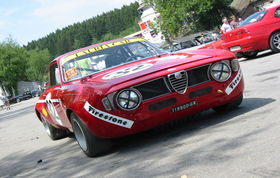
| |
| Alfa Romeo GTA Junior | |
|---|---|
| Production | 1968–1972 |
| Body style | 2-door coupe |
| Engine | 1.3 L straight-4 |
The GTA 1300 Junior (1968–1972) had an 1300 cc engine that was based on the 1600 engine but with a short stroke crankshaft. The GTA Junior in 'stradale' form did not have many of the light weight features of the 1600 GTA, such as the plastic windows, magnesium engine components and alloy wheels. At start the engine produced 96PS but was soon raised to 110PS. Autodelta prepared fuel injected racing cars had 165PS. 450 GTA Juniors were produced.
GTAm
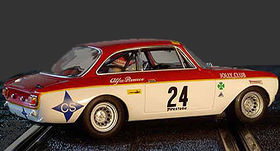
| |
| Alfa Romeo GTAm | |
|---|---|
| Production | 1970–1971 |
| Body style | 2-door coupe |
| Engine | 2.0 L straight-4 |
The GTAm (1970–1971) could produce up to 240PS in the 2000 cc car—a car usually related to the GTA, but unlike the GTA derived from the GTV 1750, the 2000GTAm was created in 1968: There are two schools of thought about the "Am", neither one of them ever being confirmed by the factory: one says Alleggerita Maggiorata ("lightened enlarged", in Italian), the other America Maggiorata. Most likely the latter is closest, since the car body did not contain any aluminum part and therefore was not "Allegerita", and the base was a GTV 1750 with American injection system for homologation purposes for the American market. SPICA was the injection system brand. The 1750 (actually 1779 cc) was bored to 1985 cc to meet the 2000 cc limitation of its class to the maximum, so explaining what "maggiorata" stands for.
1970 Alfa Romeo 1750 GTAm Autodelta
GTA-SA
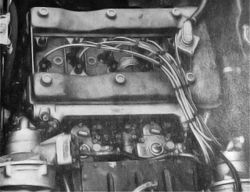
| |
| Alfa Romeo GTA-SA | |
|---|---|
| Production | 1967–1968 |
| Body style | 2-door coupe |
| Engine | 1.6 L straight-4 supercharged |
The Giulia 1600 GTA-SA (sovralimentato or supercharged) (1967–1968) was very rare racing car, of which only 10 copies were built. The car featured a 1570 cc twinspark engine with two oil driven superchargers and could produce up to 250 PS at 7500 rpm. The GTA-SA was built for FlA Group 5 racing in Europe and it won first place overall in the Hockenheim 100 mile endurance race in 1967 in the hands of the German driver Siegfried Dau.
Racing success
Both types the GTA/ GTA 1300 Junior and the GTAm were very successful, these cars were led to numerous victories. In the opening season at Monza, they won the first seven places. Andrea de Adamich claimed the title in 1966. Later on, the 1750 GTAm and the 2000 GTAm cars were led to victory by Toine Hezemans, who won the 24 hours of Francorchamps with this car. These cars won hundreds of races before competition grew stronger in 1971. But the Giulia sometimes kept up with much bigger engined cars such as the 3 liter BMW CSL.
Technical data
| GTA: | Giulia Sprint GTA | Giulia Sprint GTA (racing version) | Giulia GTA 1300 Junior | Giulia GTA 1300 Junior (racing version) | GTA SA | GTAm |
|---|---|---|---|---|---|---|
| Engine: | straight-4 | |||||
| Displacement: | 1570 cc | 1570 cc | 1290 cc | 1290 cc | 1570 cc | 1985 cc |
| Bore x stroke: | 78 mm x 82 mm | 78 mm x 82 mm | 78 mm x 67.5 mm | 78 mm x67.5 mm | 78 mm x 82 mm | 845 mm x 88.5 mm |
| Power: | 115 PS | 164 PS | 96 PS | 180 PS | 220 PS | 240 PS |
| at rpm: | 6000 | 7800 | 6000 | 9300 | 7800 | 7500 |
| Compression: | 9,7 : 1 | 10,5 : 1 | 9,7 : 1 | 11,0 : 1 | 10,5 : 1 | 11,0 : 1 |
| Valves per cylinder: | 2 | 2 | 2 | 4 | 2 | 2 |
| Valve control: | Double overhead camshaft | |||||
| Transmission: | 5-speed gearbox | |||||
| Brakes: | Disc brakes all around | |||||
| Suspension front: | Independent suspension, wishbones , coil springs, anti-roll bar | |||||
| Suspension rear: | Live Axle , trailing arms, coil springs, telescopic dampers | |||||
| Body: | two-door, aluminum panels over steel monocoque | two-door from steel | ||||
| Weight: | 820 kg | 760 kg | 920 kg | 760 kg | 920 kg | |
| Top speed: | 185 km/h | 220 km/h | 175 km/h | 210 km/h | 240 km/h | 230 km/h |
| Construction: | 1965 - 1969 | 1965 - 1969 | 1968 - 1975 | 1968 - 1975 | 1967 - 1968 | 1970 - 1971 |
| Quantity: | 500 | 193 | 300 | 10 | 40 | |
Modern GTAs
The designation GTA is now used on the highest performance versions of Alfa Romeo road cars, such as the 147 and now discontinued 156. These cars are powered by V6 engines giving them the most power of the cars in the model range, however despite the GTA name, they are generally the heaviest cars in the range, due to having large engines and little if any weight saving employed in their construction. For example, the 147 GTA weighs 1360 kg.
147
The 147 GTA was introduced in 2002 as the top-end hatchback model for Alfa Romeo. It is powered by a 3.2 litre V6, derived from the 164 from the early 90s. It is a two-door hatchback that seats five, and is characterized by its wider wheel arches, teledial 17 inch wheels, and more aggressive grille design.
156
The 156 GTA was Alfa Romeo's sportiest version of the 156, and used the same 3.2 liter V6 as the 147 GTA, producing 250 PS and 300 Nm lb·ft of torque. This four-door saloon was available in sedan or wagon versions.
Mito
The Mito GTA is a 1.75 liter, turbocharged straight-4, producing 240 PS.
See also
External links
- The Alfa Romeo car company
- History of the European Touring Car racing championship - Cars and Results
- A link to an Alfa Romeo GTAm restoration web site - pictures and history of the restoration of this classic racer
References
- Alfa Romeo Alleggerita Giulia Sprint GTA, Tony Adriaensens, ISBN 90-801197-1-7
- Alfa Romeo Giulia Coupe GT and GTA, John Tipler, ISBN 1-903706-47-5
Video Links
Alfa Romeo Giulia GTA, GTV 1750, GTV 1300 Jr.
| <- Previous | Alfa Romeo Automobiles S.p.A., a subsidiary of the Fiat S.p.A. since 1986, car timeline, 1946-1979 | Next -> | ||||||||||||||||||||||||||||||||||||||||||
| Type | 1950s | 1960s | 1970s | |||||||||||||||||||||||||||||||||||||||||
| 0 | 1 | 2 | 3 | 4 | 5 | 6 | 7 | 8 | 9 | 0 | 1 | 2 | 3 | 4 | 5 | 6 | 7 | 8 | 9 | 0 | 1 | 2 | 3 | 4 | 5 | 6 | 7 | 8 | 9 | |||||||||||||||
| Small family car | Dauphine* | Alfasud | ||||||||||||||||||||||||||||||||||||||||||
| Compact executive car | Giulietta (750/101) | |||||||||||||||||||||||||||||||||||||||||||
| Giulia | Giulietta (116) | |||||||||||||||||||||||||||||||||||||||||||
| 1750 | Alfetta | |||||||||||||||||||||||||||||||||||||||||||
| Executive car | 1900 | 2000 | 2600 | 2000 | Alfa 6 | |||||||||||||||||||||||||||||||||||||||
| Cabriolet | 1900 | 2000 | 2600 | |||||||||||||||||||||||||||||||||||||||||
| Coupé | Giulietta | Sprint | ||||||||||||||||||||||||||||||||||||||||||
| Giulia | Alfetta GT/GTV and GTV6 | |||||||||||||||||||||||||||||||||||||||||||
| 1900 | 2000 | 2600 | ||||||||||||||||||||||||||||||||||||||||||
| Roadster | Spider | |||||||||||||||||||||||||||||||||||||||||||
| Gran Sport Quattroruote | ||||||||||||||||||||||||||||||||||||||||||||
| Sports car | …6C 2500 | Montreal | ||||||||||||||||||||||||||||||||||||||||||
| 33 Stradale | ||||||||||||||||||||||||||||||||||||||||||||
| Off-road | Matta | |||||||||||||||||||||||||||||||||||||||||||
| Racing car | TZ/GTA | |||||||||||||||||||||||||||||||||||||||||||
| …158/159 | Tipo 33 | 177 | ||||||||||||||||||||||||||||||||||||||||||
| *Dauphine was produced under Renault license | ||||||||||||||||||||||||||||||||||||||||||||
